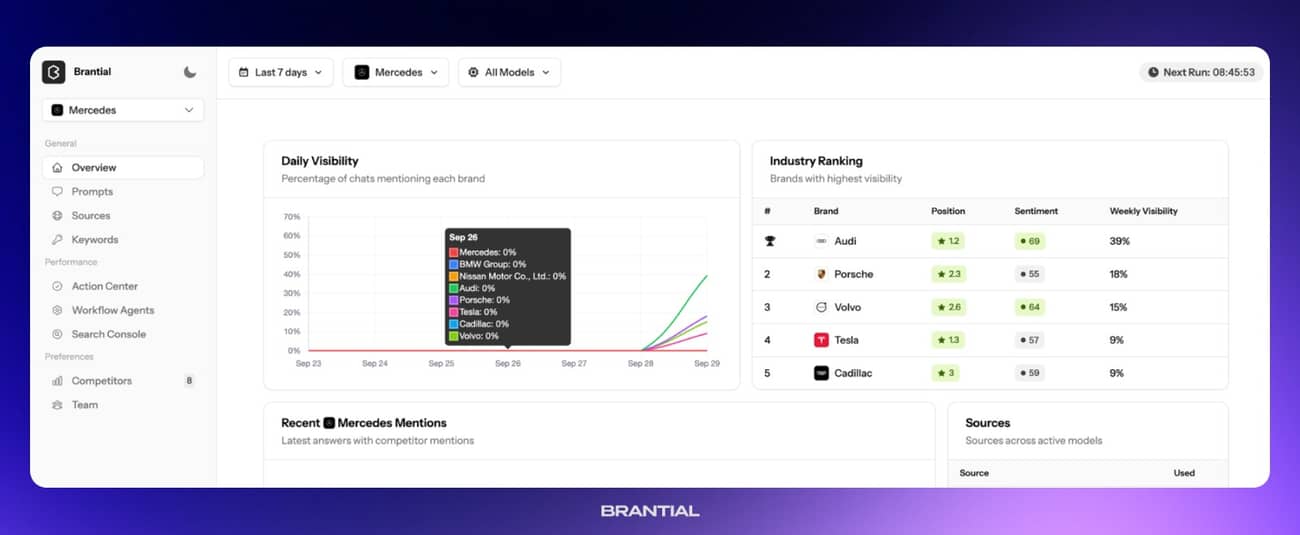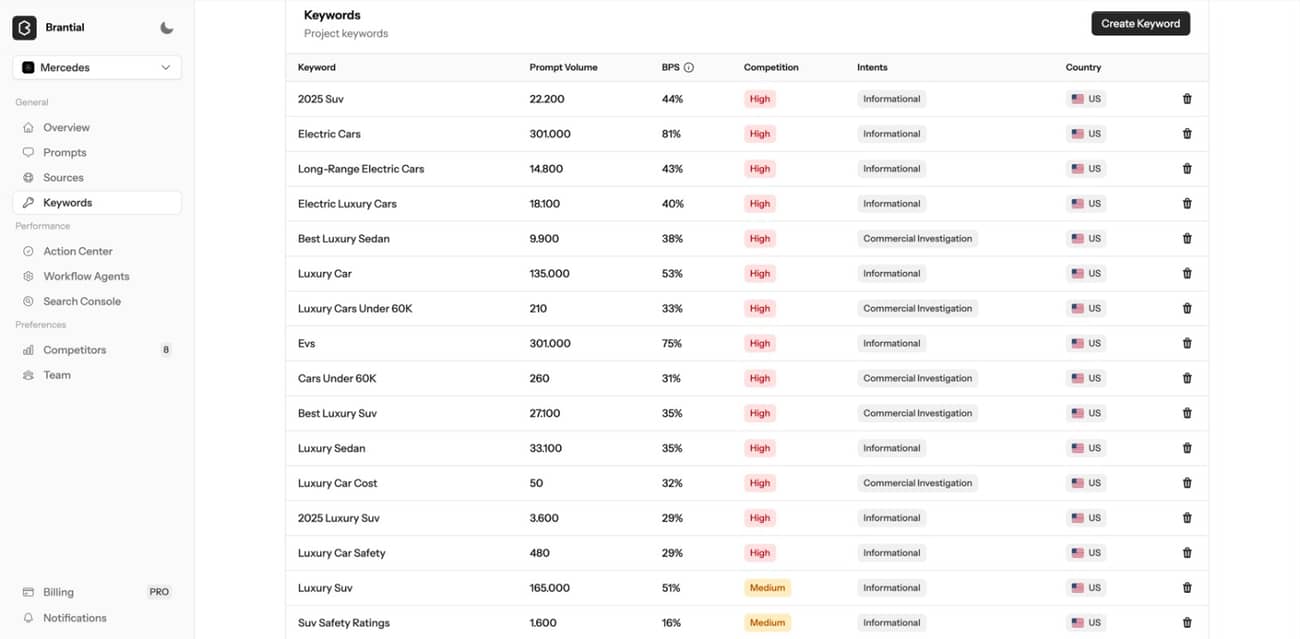Is It Possible to Increase Sales With Artificial Intelligence Search?
AI search can boost sales through better visibility, personalization, and trust. Learn how to grow your brand with AI today.
The way people discover, compare, and decide what to buy is changing faster than ever. For years, search engines shaped how brands reached their audiences — but now, artificial intelligence is redefining that journey. Instead of typing keywords into a search bar, users are asking conversational questions, relying on AI assistants, and getting personalized, context-rich answers.
This transformation raises an exciting question for businesses: can AI-powered search actually help increase sales?
The short answer is yes — but not by accident. Success in the age of AI search depends on understanding how these new systems work, how they interpret intent, and how visible your brand is within them. From optimizing your content for generative engines to leveraging AI visibility insights, companies that adapt early are already seeing measurable growth.
How AI Search Impacts the Buyer Journey
AI-powered search doesn’t just change how users find information — it reshapes the entire buyer journey from awareness to conversion. Each stage of the funnel now looks and behaves differently because of how AI interprets intent and delivers results.
1. Awareness: Being Discovered in AI Conversations
In traditional search, awareness relied on keywords and rankings. In AI search, it’s about being mentioned or cited in conversational results. When a user asks an AI assistant, “What are the best sustainable clothing brands?”, the engine compiles a short, authoritative answer — sometimes referencing specific names or linking to sources.
If your brand is recognized as credible and relevant, you might be included in that answer — even if the user never typed your name. That’s a powerful new form of brand discovery.
2. Consideration: Context-Rich Recommendations
As AI tools analyze user preferences and past behaviors, they tailor recommendations with impressive precision. Buyers can ask follow-up questions like, “Which of these is more affordable?” or “What fits best for small teams?”
This means the content surrounding your brand — reviews, structured data, and topical authority — plays a key role in whether you remain part of the conversation. If your product information is clear, complete, and semantically aligned with user intent, AI systems are more likely to surface you as a relevant option.
3. Conversion: Trust and Ease of Decision-Making
AI doesn’t just suggest products; it simplifies decisions. Generative search can compare features, summarize feedback, and even link directly to checkout pages or affiliate listings. For users, that reduces friction. For brands, it shortens the path from discovery to purchase.
The more accurately AI understands your product’s value and category, the more confidently it can recommend you — and that confidence directly translates to higher conversion potential.
4. Retention and Loyalty: Staying Top-of-Mind
The buyer journey doesn’t end at checkout. AI tools are also becoming part of post-purchase experiences — offering usage tips, recommending complementary products, or re-engaging users with timely updates.
Brands that continue to appear in these AI-driven contexts stay visible long after the first sale, nurturing loyalty and repeat purchases.
Understanding and Measuring AI Search Visibility
If AI search is transforming how people discover and buy, then visibility within these systems has become the new digital currency. But unlike traditional SEO — where impressions, clicks, and rankings are easy to measure — AI visibility is harder to define.
When someone asks ChatGPT, Perplexity, or another AI-powered assistant for product recommendations, the response isn’t a list of ten blue links. It’s a curated, synthesized answer built from multiple sources. That means a brand’s visibility depends not only on how well it ranks, but also on how often it’s cited, summarized, or referenced in AI-generated results.
Why AI Visibility Matters
- It captures real influence. AI-driven results often serve as the final answer for users — they may not continue to traditional search.
- It’s predictive of future sales. Brands that frequently appear in AI responses enjoy more trust and exposure during early research stages.
- It guides smarter content strategies. Knowing which queries or prompts include (or exclude) your brand helps shape your next campaigns.
How Businesses Can Track This New Visibility Layer

Until recently, there was no reliable way to measure AI visibility. But a new wave of tools is emerging to fill that gap — helping marketers see how their brands perform in AI-driven environments.
For instance, platforms like Brantial allow brands to analyze their visibility across AI search engines and large language models with data-rich, interactive dashboards. The platform visualizes brand mentions, keyword prompts, and content opportunities — giving marketers a clear picture of how their brand performs in the AI search landscape.

You can uncover insights such as:
- How frequently your brand is mentioned across AI-powered search engines and chat environments.
- How your visibility trends compare to competitors over time, including shifts in ranking and sentiment.
- Which keywords and prompts drive discovery, along with their search volume, intent, and competition levels.
- Where to focus your content and messaging efforts to increase visibility and improve brand performance within AI-generated answers.
Practical Strategies to Boost Sales Through AI Search
Knowing how AI search works — and where your brand stands — is only the beginning. The real growth happens when you take strategic action to make your business more discoverable, more relevant, and more trusted by AI systems. Below are some practical, sales-driven steps to help you turn AI visibility into measurable results.
1. Optimize for Conversational and Intent-Based Queries
AI tools interpret intent, not just keywords. That means your content should sound like the questions real users ask — and the answers they want. Instead of writing for “best project management software,” build content that answers:
- “Which project management software is easiest for small teams?”
- “How do startups organize workflows efficiently?”
Use natural phrasing, real user language, and context-rich explanations. This helps AI systems understand and recommend your content.
2. Strengthen Your Brand’s Topical Authority
AI search engines favor credible, expert sources. To build authority:
- Publish original insights, guides, and data that reflect your expertise.
- Earn citations and backlinks from trusted sources.
- Keep your product and brand information consistent across platforms.
A strong topical profile makes your brand more likely to appear in AI-generated summaries and product suggestions.
3. Structure Your Data for AI Readability
Structured data isn’t just for Google anymore. Schema markup, well-defined metadata, and clean product feeds make it easier for AI systems to interpret and contextualize your content. Include clear product attributes (features, pricing, reviews) and mark them up properly so they can be ingested by AI crawlers and discovery engines.
4. Use AI Visibility Insights to Find Opportunities
This is where insights from tools like Brantial become invaluable. By analyzing which AI engines mention your brand — and where you’re missing — you can discover new prompts, categories, or questions to target.
5. Align Content With the Buyer Journey
Don’t stop at awareness. Create content that helps at every stage of the buyer journey — comparison guides, FAQs, pricing breakdowns, and testimonials. AI search tools often draw from this type of detailed content when summarizing recommendations, meaning your helpful information can become the AI’s “voice” promoting your product.
6. Monitor, Adapt, and Evolve
AI search is evolving rapidly. Track how your visibility changes over time, measure referral traffic from AI-integrated platforms, and continuously refine your content strategy. The businesses that treat AI visibility as an ongoing process — not a one-time fix — will maintain a competitive edge as the landscape matures.
When applied together, these strategies transform AI search from a curiosity into a sales engine. They help you meet potential buyers at every step of their journey — right inside the AI tools they already trust.
The Future of Sales in the AI Search Era
AI search is not a passing trend — it’s the foundation of how consumers will discover, evaluate, and purchase products in the coming years. As these systems become smarter and more personalized, the line between search and recommendation will continue to blur.
1. From Search to Discovery
In the near future, AI won’t wait for users to search — it will anticipate what they need. Imagine an AI assistant that suggests the right product before you even realize you’re looking for it. For brands, this means preparing content and data that can feed into predictive and proactive discovery models.
2. Multimodal and Voice-Driven Experiences
Search is expanding beyond text. Users are interacting with AI through voice, images, and even video prompts. Visual and multimodal discovery will open new ways for products to be presented — for example, AI tools might generate comparison charts or shopping recommendations from a photo or spoken query. Brands that invest in structured data, clear visuals, and accessible language will perform better in this environment.
3. Hyper-Personalization at Scale
AI’s ability to understand context means that two users asking the same question might see completely different results. This personalization extends beyond search — into product recommendations, ad delivery, and content experiences. To keep up, brands need dynamic strategies that adapt to user intent, location, and past interactions in real time.
4. The Rise of AI Visibility Optimization (AIVO)
Just as SEO became an essential discipline for traditional search, AI Visibility Optimization (AIVO) is emerging as the next frontier. Companies will increasingly use specialized platforms — such as Brantial — to measure and improve how their brand appears across AI-powered interfaces. Those who treat AI visibility as a long-term strategy will have a major competitive edge.
5. Building Trust in the Age of Automation
Even as AI systems grow more autonomous, human trust remains central. Consumers want to know that the information they receive — whether from a chatbot or a search assistant — is accurate and aligned with their values. Brands that demonstrate authenticity, social responsibility, and transparency will thrive in this new ecosystem.
In short, the future of AI search isn’t just about being found — it’s about being trusted, recommended, and remembered. The sales leaders of tomorrow will be the ones who understand this shift early and evolve with it.